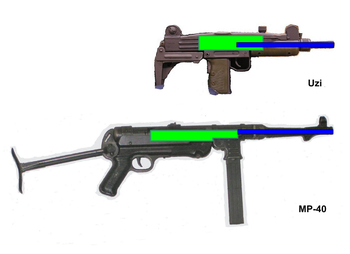- Telescoping bolt
-
A weapon with a telescoping bolt (also known as an overhung bolt) is one with a bolt which telescopes over, that is, wraps around and past, the breech end of the barrel. This feature reduces the required length of a weapon such as a submachine gun significantly, and it allows rifle designs to be balanced around the pistol grip in a way that gives "pointability" similar to a pistol's.
While it would be simpler and easier to shorten the bolt to fit completely behind the breech, the bolt must have a certain amount of mass in order to operate reliably with a given caliber. The telescoping bolt moves some of that mass forward of the bolt face, resulting in a bolt which is longer overall, but is shorter behind the bolt face.
Though technically a different, distinct concept, nearly all telescoping bolt submachineguns do use an ammunition magazine located in the pistol grip which is used to hold the weapon.
Contents
History
The telescoping bolt concept first appeared on semi-automatic handguns designed by John Browning, such as the M1911-series pistol produced for the U.S. Army. These pistols feature a slide, which acts as both a barrel shroud and the bolt. This allowed Browning to design compact pistols for high-powered cartridges.
The first production model submachinegun using the telescoping bolt concept was the Czechslovakian Cz 23 aka Sa.23 or vz.48b series, first produced in 1948. These submachineguns use a cylindrical telescoping bolt with centered barrel. While widely exported in the third world, the Cz 23 series were not well known in the west. [1]
The popularly well known first example was the Uzi submachine gun, designed in Israel by a designer inspired by the Cz 23 series. This gun has become probably the best known submachinegun of all time. It uses a rectangular bolt, with a barrel which is offset toward the bottom of the bolt. This configuration places the axis of recoil lower, increasing the controllability of the weapon in full-automatic fire. The Uzi was designed in 1948 after first models of the Cz 23 were seen, and entered service in 1951.
Subsequently, the telescoping bolt has been used in a wide variety of submachinegun designs.
Comparisons
As the image diagrams demonstrate, the basic concept of telescoping bolt and magazine well in handgrip produce significantly more compact weapons. These diagrams show the 1938 design (1939 service) MP-40 submachinegun, which is 630 mm (25 inch) long, weighed around 4 kilograms (8.8 pounds) and has a 251 mm (10 inch) barrel, and the similar materials and production technology Uzi, a 1948 design (1951 service), which is 470 mm (19 inch) long with stock folded and weighed 3.5 kilograms (7.7 pounds) and uses a 251 mm (10 inch) barrel.
Utilizing nothing more than a configuration change, and the same materials and fabrication technologies, the Uzi is 500 grams (1 pound) lighter and 160 mm (6 inches) shorter.
Examples
- Cz 23 series
- Uzi
- Ingram MAC-10 and MAC-11
- Steyr MPi 69
References
- ^ Back to the Roots, Monty Mendenhall, at [1], accessed Jan 10, 2007
Categories:- Firearm components
- Telescoping bolt submachine guns
Wikimedia Foundation. 2010.


